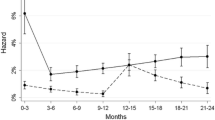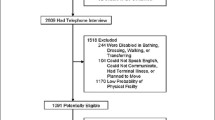Abstract
Predictors of non-response were investigated in a 15-year follow-up (1981–1996) of 3,481 individuals in a probability sample from the household population of East Baltimore. Demographics (age, sex, race, education, marital status, and unemployment), household factors (living arrangements, household income, household size, and number of children), cultural variables (ancestral ethnicity and foreign language), social variables (social support and networks, committing felony, carrying a weapon, using an alias, and wandering), health factors (physical illness, health insurance, medical assistance, Medicare, receiving disability benefits, social security, and welfare), interviewer's observation, and psychopathologic variables (mental disorders, suicide behavior, comorbidity, and drug use) were collected at baseline in 1981 and in 1982, then linked to follow-up data between 1993 and 1996. A tracing process involving mail, phone, criss-cross directories, motor vehicle administration records, a commercial credit bureau, the state criminal justice system, hospital records, the US National Death Index, and field tracing were used to locate the original sample. A total of 3,066 respondents of the original sample (88.1%) were traced. Non-response was categorized into Sample Mortality (that part of the original sample that died during follow-up), Sample Loss (that part of the original sample that survived but could not be found) and Refusal (that part of the original sample that survived and was found but refused to participate). Stratified analysis and adjusted multiple logistic regression modeling found sample mortality and sample loss were strongly influenced by individual and household variables and by psychopathology. Sample mortality was influenced by specific mental disorders or conditions as mania, drug abuse/dependency, antisocial personality, cognitive impairment, alcohol abuse/dependency, phobia, drug use (except PCP), and comorbidity. Household factors protective against mortality include higher household income, not living as extended members in a married couple family, and living with children in the household. Persons who were unemployed, widowed or single, without high school education, male, and 65 years of age or older were more likely to die. Sample loss was influenced by cognitive impairment, antisocial personality, and cocaine use. Household factors linked to sample loss include living in female-headed families, or non-family households, and living alone. Young nonwhite, divorced/separated, without high school education, and unemployed were also harder to find. Refusal was associated with being white, with incomplete elementary education, living as a spouse in traditional married couple families, or as a child in female-headed families. Psychopathology did not influence refusal.
Similar content being viewed by others
Author information
Authors and Affiliations
Additional information
Accepted: 7 May 1998
Rights and permissions
About this article
Cite this article
Badawi, M., Eaton, W., Myllyluoma, J. et al. Psychopathology and attrition in the Baltimore ECA 15-year follow-up 1981–1996. Soc Psychiatry Psychiatr Epidemiol 34, 91–98 (1999). https://doi.org/10.1007/s001270050117
Issue Date:
DOI: https://doi.org/10.1007/s001270050117




